Is Basting Spray Bad for Quilts? Podcast Episode #42
Or you can watch the episode and see what I’m working on with this video:
Basting spray is an aerosol glue you can use to spray the layers of your quilt so they stick together. It’s a faster basting method in comparison to pin basting or hand basting, and I know many quilters that prefer to use spray basting because it’s easier on their hands.
As with all my Great Quilting Debate episodes, I 100% believe you should use what you want and what works for you! I use polyester thread for quilting, I like to prewash and starch all my fabric before cutting, and I press my seams open – all of these are topics that quilters argue about.
But I rarely hear anyone arguing about basting spray and this worries me. I get questions weekly about whether starch will make their quilts more susceptible to bugs (a ridiculous quilting rumor in my opinion), but I never get questions about the effects of basting spray – a far more detrimental chemical.
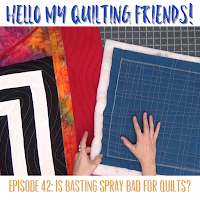 Maybe this is because I don’t use basting spray so quilters are taking their questions about it elsewhere. Or maybe quilters don’t know about the possible side effects of using this chemical in their quilts.
Maybe this is because I don’t use basting spray so quilters are taking their questions about it elsewhere. Or maybe quilters don’t know about the possible side effects of using this chemical in their quilts.
A few years ago I ran across a research paper put out by the University of Nebraska-Lincoln on the effects of lots of different glues commonly used in quilts including basting spray, fusible webs, and fusible batting. The conclusion was very clear from this study – if you want to create a quilt that will last beyond your lifetime (100 years +) or be considered a good candidate for museum curation, none of these materials should be used in the quilt.
Click Here to find the article I wrote in 2011 about chemicals in quilts.
Of course, I know a lot of quilters don’t care about their quilt going in a museum or outliving them! I know this matters very little if you want to make a quilt for all 18 of your grandchildren by Christmas and pin basting makes your hands hurt.
Again, use what works and helps you make your quilts.
But please make sure you are using this chemical safely. Our sewing rooms are NOT well ventilated and I don’t think it’s safe to spray basting glue in the house and especially near a sewing machine. Not all brands of basting spray are smelly, but glue is glue, and glue isn’t good for our lungs to breathe or land near our machines either!
If you do use basting spray, please use it outside.
My quilting friend Christa Watson has a great tutorial on spray basting. She sprays her quilts outside, then brings the layers back inside to squish them together. Click Here to find Christa’s spray basting tutorial.
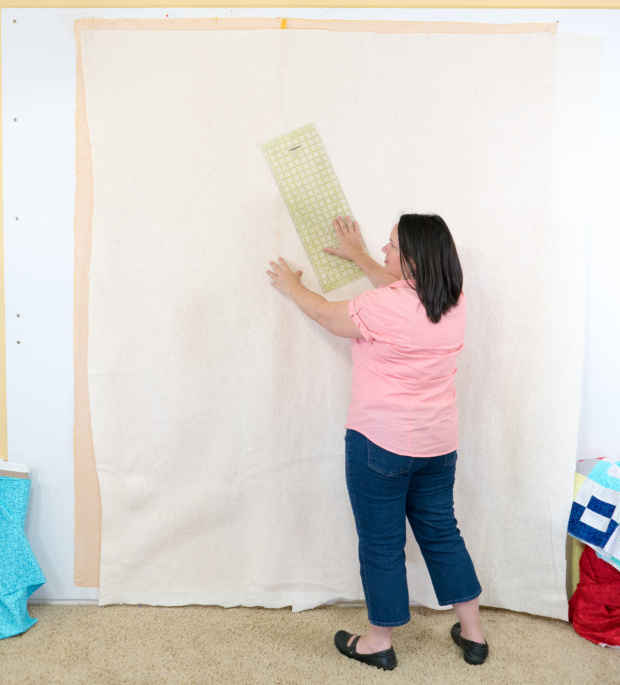 |
| Photo from ChristaQuilts.com |
Christa recently updated this tutorial to show you how to spray baste vertically using a design wall as well. Click Here to find this new tutorial.
Whew! That was quite a bit of a basting rant, but these Great Quilting Debates are debates for a reason. We all have different opinions about these materials and what is best for our quilts. Ultimately you just have to decide what works for you and helps you create the quilts you want to make.
Get the Basics of Basting under your Belt (and say that three times fast!)
I know I’m feeling particularly opinionated about basting because I’ve just finished a new online quilting workshop on this topic. If you’d like to learn more about quilt basting and dig into this subject more, please join me for the Basting Basics Workshop!
This online quilting class covers all the topics of basting, and we pin baste a baby quilt, a king sized quilt, and teach machine basting as well.
I prefer to either pin or stitch the layers of my quilts together because it doesn’t add any extra chemicals or glues to the quilt that I have to worry about later.
I also include a lot of information on picking your batting – one of the most crucial choices when it comes to basting your quilts. I had a lot to share about batting because this layer ultimately determines how long it will take to quilt your quilt.
So if this podcast episode has peaked your interest in quilt basting, please join me for a quilting class to learn more. Click here to find the Basting Basics Workshop!
Stitching and Quilting Updates…
Now I’ve mostly been working on this workshop this week, but in my evening hand stitching time, I’ve been finishing up my Express Your Love mini embroidery. I just put the last stitches in the binding last night so it’s finally finished!
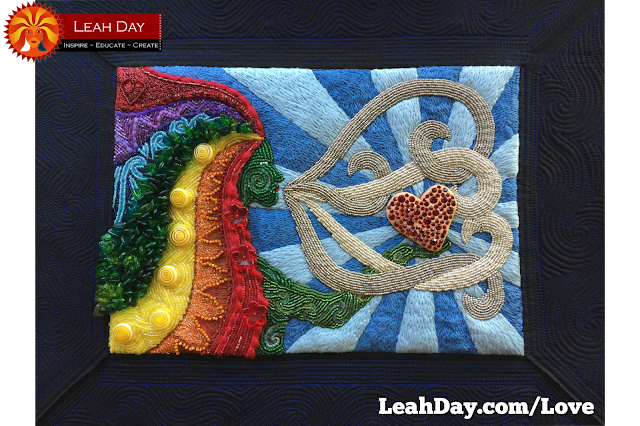
It feels awesome to be done with this little quilt, which has been in progress since 2013. I got serious about finishing it this fall and began working on it for 30 – 60 minutes every evening. When I started in September, it looked like this:
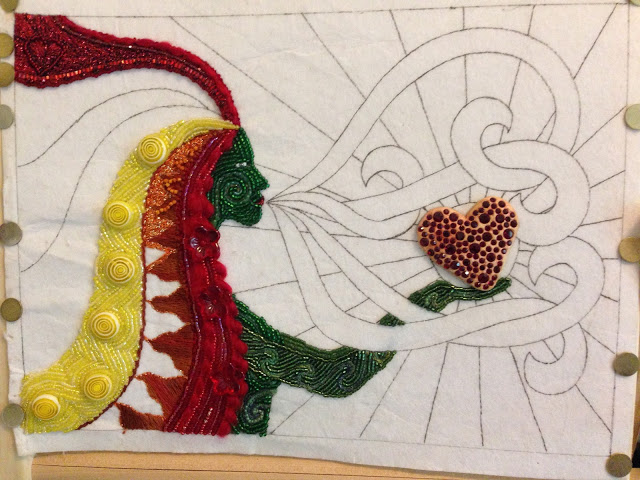
This is the power of a little work every day! Just a few minutes on a project, every single day, is so much better than just spending one day on a project once a month.
This is also how I’m writing a book. So long as I get a little done every day, I know I’m moving forward steadily. Even if it’s just a few hundred words, even if it’s just polishing what I’ve written before, that’s still forward movement.
What was the challenge this week?
My word for the year is challenge and, yes, it was a very big challenge to film all the videos and create the new basting workshop all in just two weeks! I’m delighted with how this class turned out and thrilled Josh and I could work together to make it all come together so quickly.
But a personal challenge was also put in my path over the weekend. I had a very personal reminder that life is short and none of us know how much time we have on this Earth. We can lose the ones we love in a second and then they are gone.
On Sunday I was planning to stay home and work while the guys went on a hike. But did that work really need to be done right then? Nope.
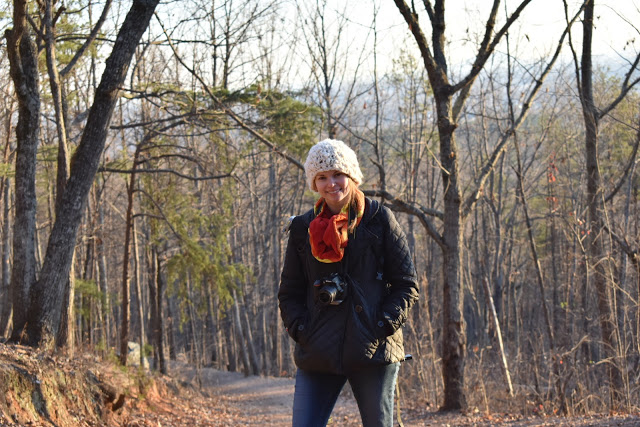
I put work aside, pulled on my boots and two layers of clothing and we climbed a mountain together. This was a wonderful day and we all had a great time!
I also went through all my photos from 2017 this week so I could make a calendar with photos from the previous year. I realized we need more days like this – more memories, more fun times together. My son is 10 and this time of him being a kid is fleeting and I want to make the most of it.
I don’t want my son only remembering me working or stitching or designing something and never being present with him, just happily walking through the woods. Because I know my son will likely mirror my habits. If I show him life is all work and no play, he will grow up to live that same life.
So that’s it for this week! Just in case I don’t say it enough, please know that I love that you’re here, reading and watching and learning with us! I feel so thankful for this life and business and I appreciate being able to share it with you.
Let’s go quilt,
Leah Day


I stopped spray basting when I found a new technique of using 8' long painted baseboards, wrapping the quilt top on one and the backing on another and pinning the batting between the two. There are YouTube tutorials on the method.
Love that you don't shy away from the controversial quilting debates Leah. I have used basting spray – as a last resort when a quilt top kept puckering however closely I pin basted it. I much prefer the chemical-free methods though. Your mini embroidery is amazing ☺ Thank you for the reminder to spend time away with family.
Thanks for bringing this up Leah. I thought I understood that the spray basting washed out, but will need to double check that. I like that method of sprapying outside, folding the pieces up and bringing inside to assemble. And I wash the finished product. Another thing I have not heard anyone talking about is that a lot of cotton being grown now is GMO cotton…which perhaps in itself is not problematic, but perhaps the cotton now contains more pesticide residue (or maybe not)—-I have just not heard any discussion about it and wonder if anyone is doing any testing to see what we are being exposed to. I always prewash any fabric I bring home, but again don’t really know how much chemicals that removes. I was pleased to see that Joanns carries a line of organic fabric, but have not investigated it very much either. Hoping that more organic fabric becomes available. Well, thanks again for bringing this up!! Happy New Year!!
My life was turned upside down in the September just gibe when my mum was diagnosed with terminal cancer and give no more then 5 years to live. Then about 2weeks after that diagnosis mum developed the flesh eating infection and ended up fighting for her life. We were told on many occasions by the drs to say our goodbyes, that she wouldn't make it.
3 mths later, mum is still with us and fighting, but your comment that we don't know when life changes or when we will lose our loved ones. It has put life in perspective for me and my family.
My life now involves flying from QLD to NSW to spend as much time with mum as possible and for my daughter to see her nan and keep building memories.
Thank you for all you do, you are an inspiration to us all.
The Express Yourself Mini is absolutely beautiful. I spray bast and have had no problem.
Thanks for the info. I too believe we makers should do what works best for us overall.
The antique quilts that we love and admire didn't use glues nor fusibles and they have lasted through the ages. It gives us all something to think about.
Thank you for sharing Tami! It sounds similar to how I baste on a longarm frame now. Rolling the layers together really keeps them evenly arranged so they don't shift.
Thank you for sharing your experience!
Yes, most definitely. I just have to wonder why I hear so many bad rumors about starch, but almost nothing about basting spray.
Thank you for sharing your story Kelly. You're exactly right – we never know how much time we have with the people we love. I'm so glad you're spending as much time with your mom as possible.
That's a very good point about GMO cotton Linda. So much pesticide is used just to make a T-shirt, I can only imagine how much is ending up on cotton batting. In the end we just have to figure out what works and will last the length of time we want. I will keep an eye out for organic cotton batting!
LOL! I enjoy these debates because I end up learning quite a lot more and it leads to more questions and ideas for podcasts down the road. Thank you for your kind comments!
Thank you for sharing your thoughts and experience about spray basting. Everything you mentioned are some of the key concerns as to why I haven't tried spray basting yet. As much as I dislike pin basting, I've always been concerned about the fumes and sticky factor associated with spray basting. This just sealed the deal for me, pin basting is definitely my go-to!